Life-Cycle Assessment of the Substitution of Sand with Coal Bottom Ash in Concrete: Two Concrete Design Methods
Abstract
:1. Introduction
2. Materials and Methods
2.1. Concrete Mixture Designs
2.2. Life-Cycle Assessment
2.3. ReCiPe2016: A Life-Cycle Impact Assessment (LCIA) Method
- The ReCiPe2016 midpoint H method, evaluating the four most significant categories: GWP, terrestrial ecotoxicity (TE), fossil resources scarcity (FRS), and water consumption (WC).
- Six methodological options of the ReCiPe2016 single score method in combination with a two-stage nested (hierarchical) analysis of variance (ANOVA). The two-stage nested ANOVA was used to simultaneously evaluate the results of the six ReCiPe2016 single score methodological options [27].
2.4. Design Structure of Statistical Evaluations
2.4.1. Design Structure of the Two-Stage ANOVA Model
2.4.2. Statistical Analysis
3. Results
3.1. MIX-Fixed-SLUMP
3.1.1. The ReCiPe2016 Midpoint
3.1.2. Six ReCiPe2016 Single Score Methodological Options
3.2. MIX-Fixed-W/C
3.2.1. ReCiPe2016 Midpoint
3.2.2. Six ReCiPe2016 Single Score Methodological Options
4. Discussion
5. Conclusions
- ReCiPe2016 midpoint method. The increased substitution of sand with CBA lead to: (i) Decreases in the impacts of global warming potential, terrestrial ecotoxicity, water consumption, and increased fossil resources scarcity (MIX-fixed-SLUMP method) and (ii) increases in the impacts of global warming potential, terrestrial ecotoxicity, water consumption, and fossil resources scarcity (MIX-fixed-W/C method).
- Six methodological options of the ReCiPe2016 single score method. With increasing substitution of sand with CBA: (i) CBA0 and CBA25 caused the most environmental damage, while CBA50-CBA100 caused the least environmental damage (MIX-fixed-SLUMP method), and (ii) CBA0 and CBA25 caused the least environmental damage, while CBA50, CBA75, and CBA100 caused the most environmental damage (MIX-fixed-W/C method).
6. Contributions
7. Limitations
Funding
Conflicts of Interest
References
- Meyer, C. The greening of the concrete industry. Cem. Concr. Compos. 2009, 31, 601–605. [Google Scholar] [CrossRef]
- Hossain, M.U.; Poon, C.S.; Dong, Y.H.; Xuan, D.X. Evaluation of environmental impact distribution methods for supplementary cementitious materials. Renew. Sustain. Energy Rev. 2018, 82, 597–608. [Google Scholar] [CrossRef]
- Kua, H.W. The consequences of substituting sand with used copper slag in construction. J. Ind. Ecol. 2013, 17, 869–879. [Google Scholar] [CrossRef]
- Yaragal, S.C.; Gowda, S.N.B.; Rajasekaran, C. Characterization and performance of processed lateritic fine aggregates in cement mortars and concretes. Construct. Build. Mater. 2019, 200, 10–25. [Google Scholar] [CrossRef]
- De Schepper, M.; Van den Heede, P.; Van Driessche, I.; De Belie, N. Life cycle assessment of completely recyclable concrete. Materials 2014, 7, 6010–6027. [Google Scholar] [CrossRef] [PubMed]
- Skalny, J.P. Questions to Arnon Bentur, head, National Building Research Institute, Technion, Israel Institute of Technology, Haifa. Adv. Cement Based Mater. 1996, 3, 81–85. [Google Scholar] [CrossRef]
- The Israel Electric Corporation Ltd. Financial Reports For The Nine and Three Months Ended September 30, 2016; The Israel Electric Corporation Ltd.: Haifa, Israel, 2016; pp. 1–191. Available online: https://www.iec.co.il/EN/IR/Documents/IECFinancialReportsSeptember_2016.pdf (accessed on 10 June 2019).
- NCAB, 2013. National Coal Ash Board, Israel, General Info. 2013. Available online: http://www.coal-ash.co.il/efer.html (accessed on 12 June 2019). (In Hebrew).
- Lieberman, R.N.; Knop, Y.; Querol, X.; Moreno, N.; Muñoz-Quirós, C.; Mastai, Y.; Anker, Y.; Cohen, H. Environmental impact and potential use of coal fly ash and sub-economical quarry fine aggregates in concrete. J. Hazard. Mater. 2018, 344, 1043–1056. [Google Scholar] [CrossRef]
- Heijungs, R.; Guinée, J.B. Allocation and ‘what-if’ scenarios in life cycle assessment of waste management systems. Waste Manag. 2007, 27, 997–1005. [Google Scholar] [CrossRef]
- ISO 14040 (International Organization for Standardization). Environmental Management Life Cycle Assessment Principles and Framework; International Organization for Standardization: Geneva, Switzerland, 2006. [Google Scholar]
- Turk, J.; Cotič, Z.; Mladenovič, A.; Šajna, A. Environmental evaluation of green concretes versus conventional concrete by means of LCA. Waste Manag. 2015, 45, 194–205. [Google Scholar] [CrossRef]
- Prem, P.R.; Verma, M.; Ambily, P.S. Sustainable cleaner production of concrete with high volume copper slag. J. Clean. Prod. 2018, 193, 43–58. [Google Scholar] [CrossRef]
- Gursel, A.P.; Ostertag, C. Life-Cycle Assessment of High-Strength Concrete Mixtures with Copper Slag as Sand Replacement. Adv. Civ. Eng. 2019, 2019, 6815348. [Google Scholar] [CrossRef]
- Kou, S.C.; Poon, C.S. Properties of concrete prepared with crushed fine stone, furnace bottom ash and fine recycled aggregate as fine aggregates. Construct. Build. Mater. 2009, 23, 2877–2886. [Google Scholar] [CrossRef]
- ISO 13315-1 (International Organization for Standardization). Environmental Management for Concrete and Concrete Structures 2012, Part 1: General Principles; International Organization for Standardization: Geneva, Switzerland, 2012. [Google Scholar]
- Habert, G.; de Lacaillerie, J.B.D.; Roussel, N. An environmental evaluation of geopolymer based concrete production: Reviewing current research trends. J. Clean. Prod. 2011, 19, 1229–1238. [Google Scholar] [CrossRef]
- Brand, S. How Buildings Learn; Viking Press: New York, NY, USA, 1994. [Google Scholar]
- Gursel, A.P.; Masanet, E.; Horvath, A.; Stadel, A. Life-cycle inventory analysis of concrete production: A critical review. Cement Concr. Compos. 2014, 51, 38–48. [Google Scholar] [CrossRef]
- Napolano, L.; Menna, C.; Asprone, D.; Prota, A.; Manfredi, G. Life cycle environmental impact of different replacement options for a typical old flat roof. Int. J. Life Cycle Assess. 2015, 20, 694–708. [Google Scholar] [CrossRef]
- Pushkar, S. Life cycle assessment of flat roof technologies for office buildings in Israel. Sustainability 2016, 8, 54. [Google Scholar] [CrossRef]
- Pushkar, S.; Verbitsky, O. Effects of different allocation approaches for modeling mineral additives in blended cements on environmental damage from five concrete mixtures in Israel. Mater. Struct. 2016, 49, 4401–4415. [Google Scholar] [CrossRef]
- Ecoinvent v3.5. Ecoinvent Database Swiss Center for Life Cycle Inventory. Available online: https://www.ecoinvent.org/database/database.html (accessed on 28 August 2019).
- Goedkoop, M.; Spriensma, R. The Eco-indicator 99—A damage oriented method for life cycle impact assessment, 2001; PRé Consultants: Amersfoort, The Netherlands, 2001; p. 3821. [Google Scholar]
- Thompson, M.; Ellis, R.; Wildavsky, A. Political Cultures. Cultural Theory; Westview Press: Boulder, CO, USA, 1990. [Google Scholar]
- Huijbregts, M.A.J.; Steinmann, Z.J.N.; Elshout, P.M.F.; Stam, G.; Verones, F.; Vieira, M.; Zijp, M.; Hollander, A.; van Zelm, R. ReCiPe2016: A harmonised life cycle impact assessment method at midpoint and endpoint level. Int. J. Life Cycle Assess. 2017, 22, 138–147. [Google Scholar] [CrossRef]
- Pushkar, S. Modeling the substitution of natural materials with industrial byproducts in green roofs using life cycle assessments. J. Clean. Prod. 2019, 227, 652–661. [Google Scholar] [CrossRef]
- SimaPro, v9.0.; PRé Consultants: Amersfoort, The Netherlands, 2019.
- Picquelle, S.J.; Mier, K.L. A practical guide to statistical methods for comparing means from two-stage sampling. Fish. Res. 2011, 107, 1–13. [Google Scholar] [CrossRef]
- Hurlbert, S.H.; Lombardi, C.M. Final collapse of the Neymane-Pearson decision theoretic framework and rise of the neoFisherian. An. Zool. Fennici 2009, 46, 311–349. [Google Scholar] [CrossRef]
- Crossin, E. The greenhouse gas implications of using ground granulated blast furnace slag as a cement substitute. J. Clean. Prod. 2015, 95, 101–108. [Google Scholar] [CrossRef]
- Saade, M.R.M.; da Silva, M.G.; Gomes, V. Appropriateness of environmental impact distribution methods to model blast furnace slag recycling in cement making. Resour. Conservat. Recycl. 2015, 99, 40–47. [Google Scholar] [CrossRef]
- Celik, K.; Meral, C.; Gursel, A.P.; Mehta, P.K.; Horvath, A.; Monteiro, P.J.M. Mechanical properties, durability, and life-cycle assessment of self-consolidating concrete mixtures made with blended portland cements containing fly ash and limestone powder. Cement Concr. Compos. 2015, 56, 59–72. [Google Scholar] [CrossRef] [Green Version]
- Gursel, A.P.; Ostertag, C.P. Impact of Singapore’s importers on life-cycle assessment of concrete. J. Clean. Prod. 2016, 118, 140–150. [Google Scholar] [CrossRef]
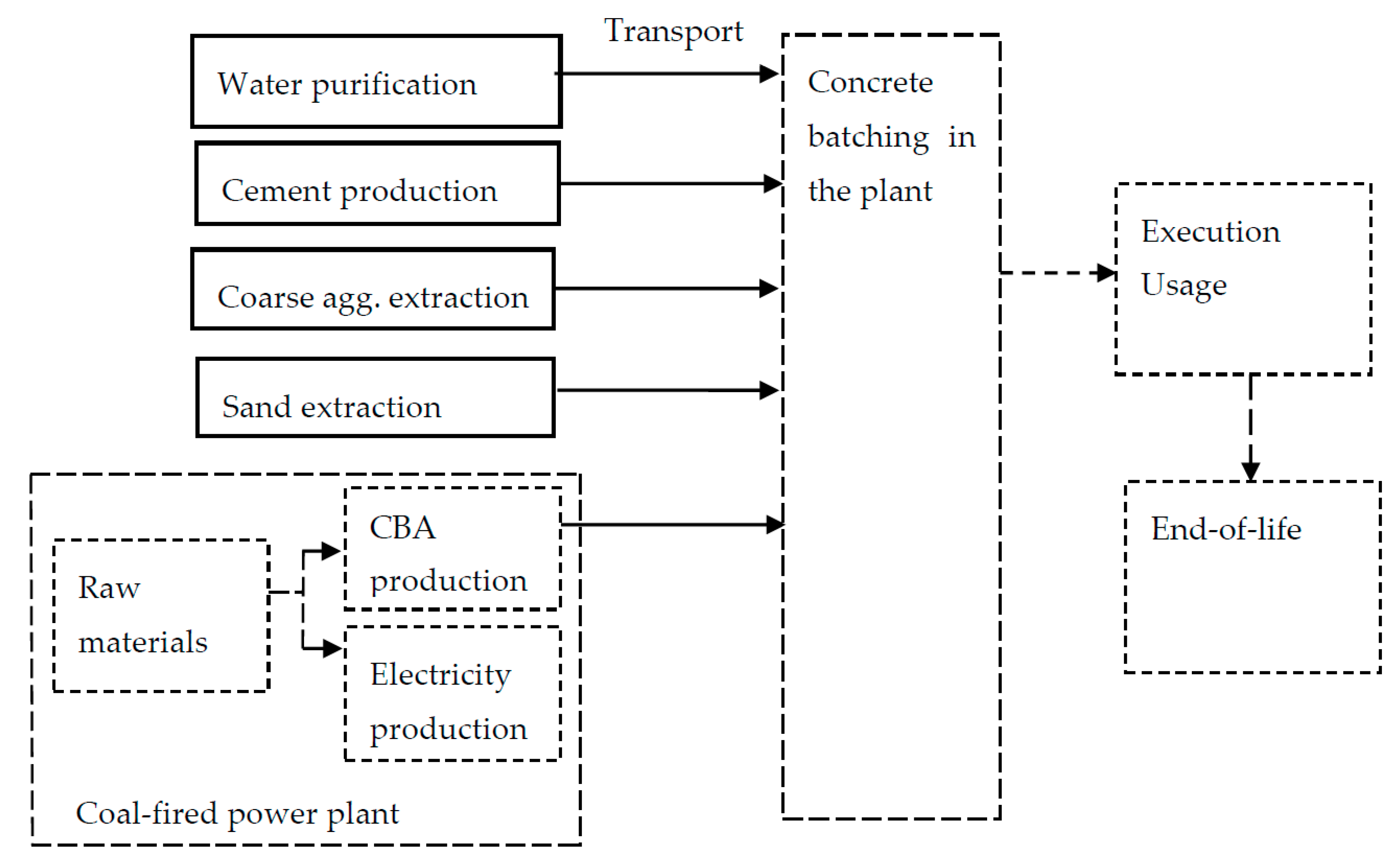
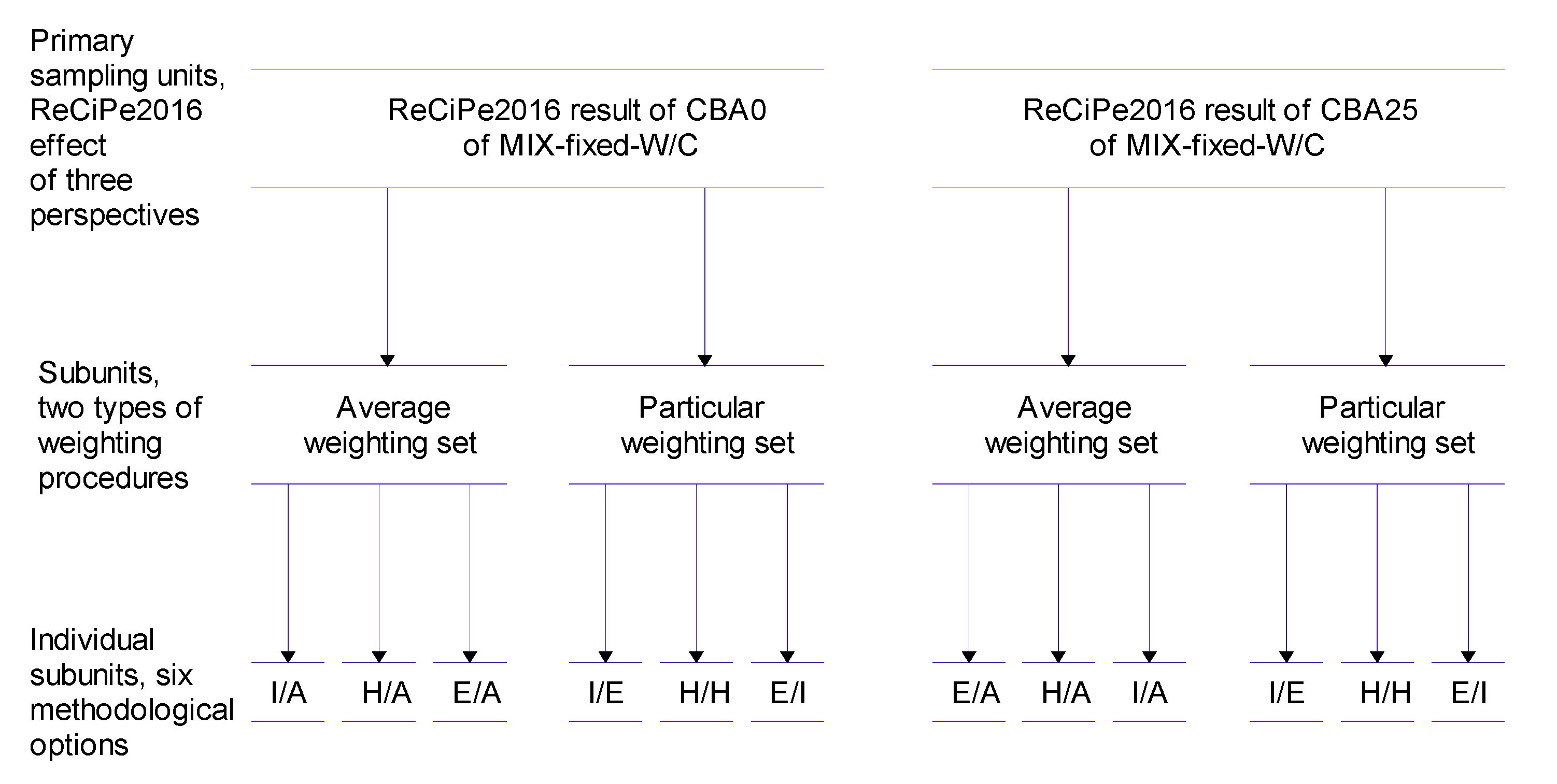
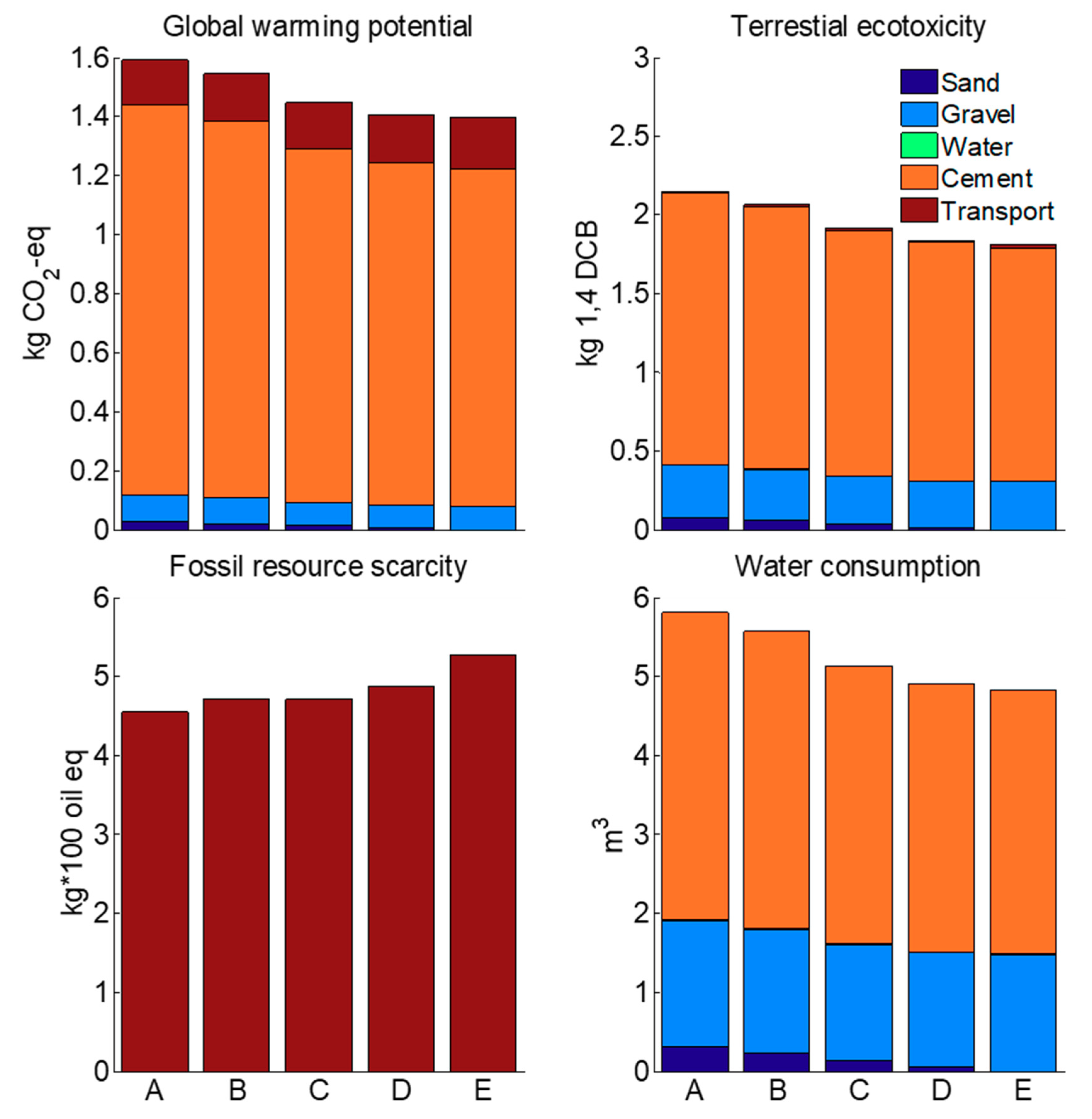
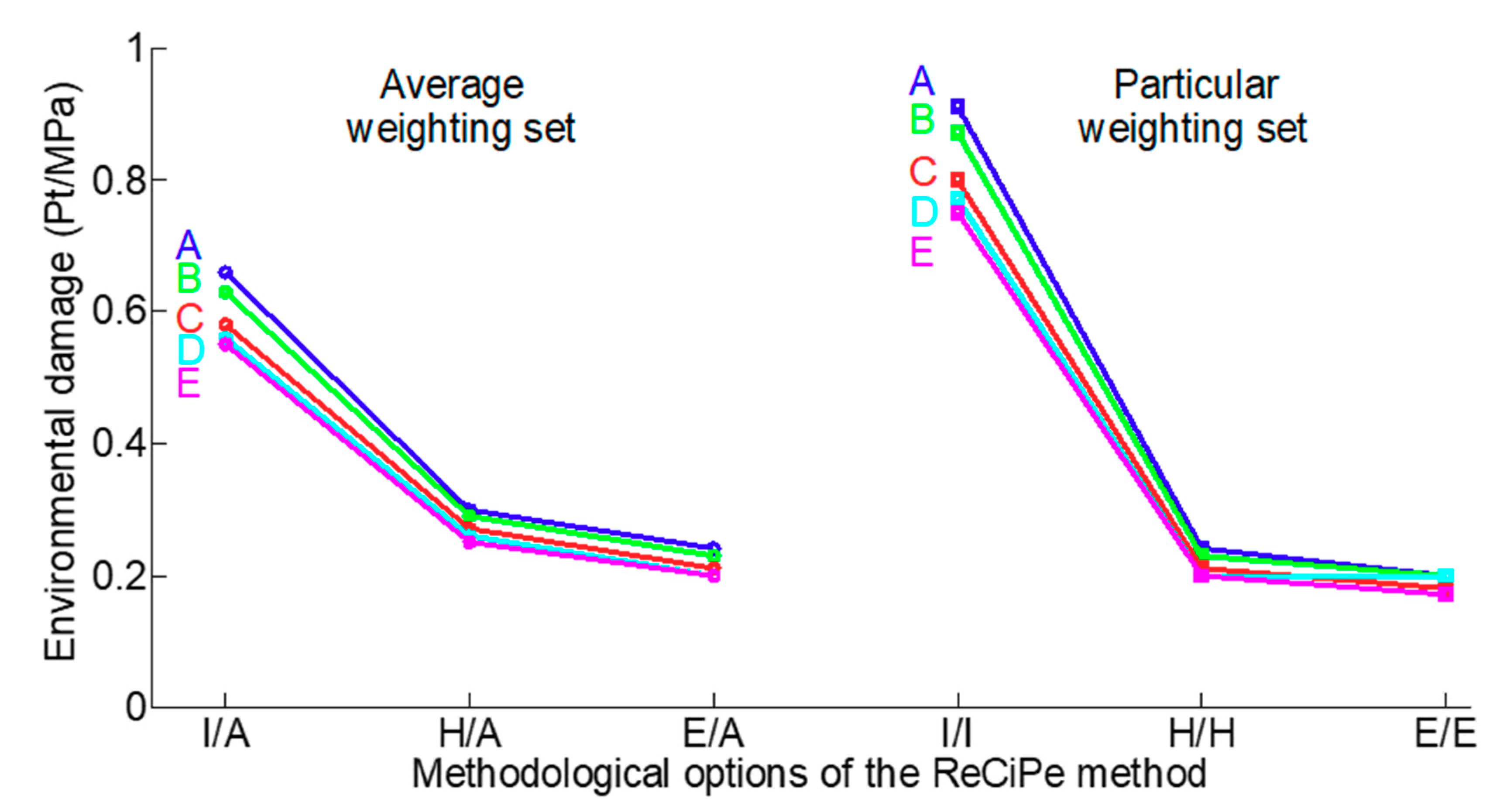
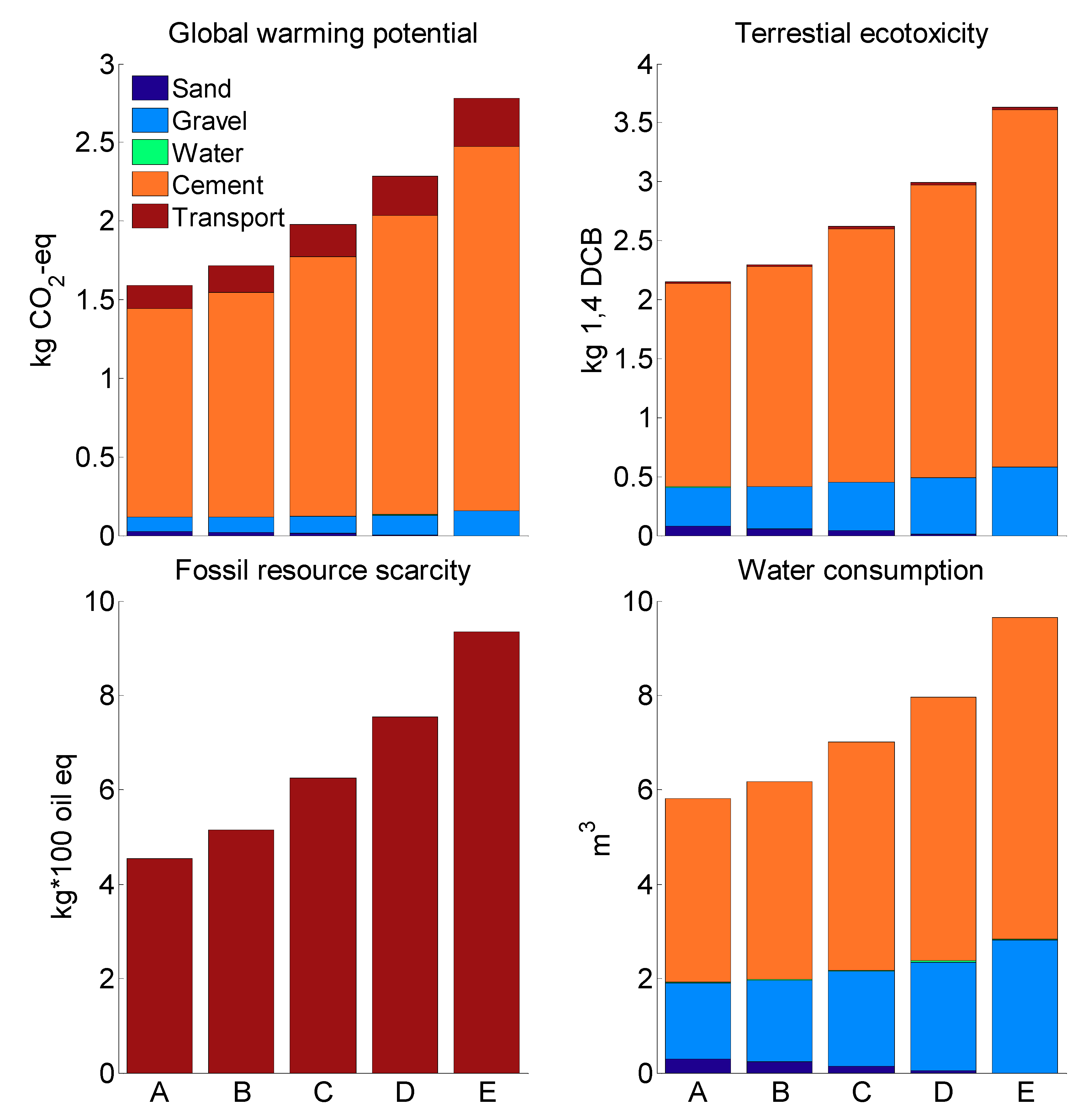
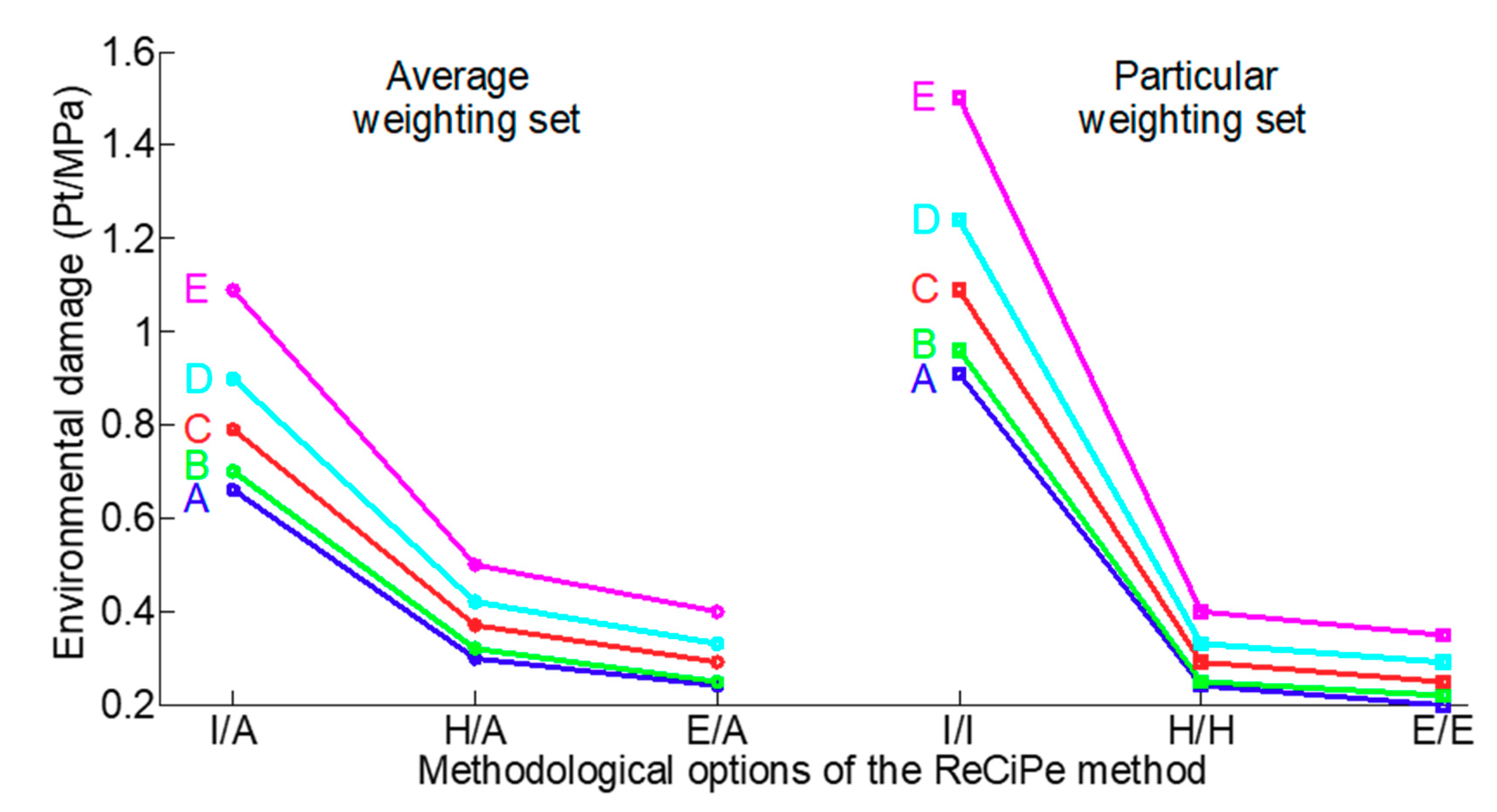
| Material | CBA0 | CBA25 | CBA50 | CBA75 | CBA100 |
|---|---|---|---|---|---|
| Portland cement (kg/m3) | 386 | 386 | 386 | 386 | 386 |
| water content (kg/m3) | 205 | 190 | 170 | 150 | 130 |
| sand (kg/m3) | 652 | 494 | 318 | 138 | 0 |
| Coal bottom ash (CBA) (kg/m3) | 0 | 167 | 343 | 529 | 725 |
| coarse aggregate (kg/m3) | 1110 | 1127 | 1126 | 1135 | 1184 |
| water/cement ratio | 0.53 | 0.49 | 0.44 | 0.39 | 0.34 |
| slump (mm) | 65 | 65 | 70 | 75 | 67 |
| 28-day compressive strength (MPa) | 56 | 65 | 70 | 75 | 67 |
| Drying shrinkage (microstrain) | 690 | 650 | 590 | 510 | 420 |
| Chloride–ion penetration (total charge passed in coulombs) | 5600 | 5200 | 5050 | 4700 | 4300 |
| Material | CBA0 | CBA25 | CBA50 | CBA75 | CBA100 |
|---|---|---|---|---|---|
| Portland cement (kg/m3) | 386 | 386 | 386 | 386 | 386 |
| water content (kg/m3) | 205 | 205 | 205 | 205 | 205 |
| sand (kg/m3) | 652 | 457 | 262 | 67 | 0 |
| Coal bottom ash (CBA) (kg/m3) | 0 | 163 | 326 | 489 | 545 |
| coarse aggregate (kg/m3) | 1110 | 1127 | 1126 | 1135 | 1184 |
| water/cement ratio | 0.53 | 0.53 | 0.53 | 0.53 | 0.53 |
| slump (mm) | 68 | 85 | 120 | 155 | 195 |
| 28-day compressive strength (MPa) | 56 | 52 | 45 | 39 | 32 |
| Drying shrinkage (microstrain) | 690 | 650 | 640 | 690 | 720 |
| Chloride–ion penetration (total charge passed in coulombs) | 5600 | 5800 | 5900 | 6000 | 6200 |
| Process | Reference in the EcoInvent Database |
|---|---|
| Water treatment | tap water, at user/CH U |
| CEM I 42.4N production | cement mortar, at plant/CH U |
| coarse aggregate extraction | gravel, crushed, at mine, CH/U |
| sand extraction | sand, at mine CH/U |
| transport | Lorry transport, Euro 0, 1,2, 3, 4 mix, 22 t total weight, 17.3 t |
| Concrete | CBA0 | CBA25 | CBA50 | CBA75 | CBA100 |
|---|---|---|---|---|---|
| CBA0 | X | 0.1632 | 0.0251 | 0.0142 | 0.0107 |
| CBA25 | X | 0.0325 | 0.0137 | 0.0104 | |
| CBA50 | X | 0.4137 | 0.0904 | ||
| CBA75 | X | 0.1203 | |||
| CBA100 | X |
| Concrete | CBA0 | CBA25 | CBA50 | CBA75 | CBA100 |
|---|---|---|---|---|---|
| CBA0 | X | 0.0750 | 0.0086 | 0.0025 | 0.0009 |
| CBA25 | X | 0.0123 | 0.0023 | 0.0006 | |
| CBA50 | X | 0.0116 | 0.0017 | ||
| CBA75 | X | 0.0030 | |||
| CBA100 | X |
© 2019 by the author. Licensee MDPI, Basel, Switzerland. This article is an open access article distributed under the terms and conditions of the Creative Commons Attribution (CC BY) license (http://creativecommons.org/licenses/by/4.0/).
Share and Cite
Pushkar, S. Life-Cycle Assessment of the Substitution of Sand with Coal Bottom Ash in Concrete: Two Concrete Design Methods. Appl. Sci. 2019, 9, 3620. https://doi.org/10.3390/app9173620
Pushkar S. Life-Cycle Assessment of the Substitution of Sand with Coal Bottom Ash in Concrete: Two Concrete Design Methods. Applied Sciences. 2019; 9(17):3620. https://doi.org/10.3390/app9173620
Chicago/Turabian StylePushkar, Svetlana. 2019. "Life-Cycle Assessment of the Substitution of Sand with Coal Bottom Ash in Concrete: Two Concrete Design Methods" Applied Sciences 9, no. 17: 3620. https://doi.org/10.3390/app9173620
APA StylePushkar, S. (2019). Life-Cycle Assessment of the Substitution of Sand with Coal Bottom Ash in Concrete: Two Concrete Design Methods. Applied Sciences, 9(17), 3620. https://doi.org/10.3390/app9173620




